Prasophyllum brevilabre
(Lindl.) Hook.f. Short-lip Leek-orchidFlowering stem 15–50 cm tall. Leaf-blade rigid, 2–6 cm long. Flowers few to many, green, red-brown and white, fragrant or not, in a loose to moderately dense spike, 5–20 cm long; ovary narrow-ovoid, almost appressed to the rachis; sepals 6–8 mm long, dorsal sepal lanceolate, red-brown, lateral sepals united, narrow-lanceolate, green or brown, margins incurved; petals linear-lanceolate, 5–8 mm long, margins pale, often white, sometimes crenulate. Labellum to 8 mm long, white, distal half folded back onto the base, margins crenulate; callus broad, flat, palest toward the channelled, blunt, wrinkled apex. Column appendages falcate-lanceolate, 2–2.5 mm long, obtuse. Flowers Sep.–Jan.
GleP, VVP, GipP, OtP, WaP, Gold, CVU, GGr, NIS, EGL, EGU, WPro, HSF, HNF, OtR, Strz, VAlp. Also NSW, Tas. Most common in the eastern half of the state in forest, woodland and heathland from coast to subalpine. Flowers Sep.-Dec. Common and widespread across higher rainfall parts of Victoria in open and closed forests, woodlands and heathlands on well-drained soils.
Flowering freely only after fires.
A distinctive species, easily recognized by the white labellum which is sharply bent back on itself, fused lateral sepals, narrow, appressed ovaries and short leaf blade.
Bates, R.J. (1994). Prasophyllum. In: Walsh, N.G.; Entwisle, T.J., Flora of Victoria Vol. 2, Ferns and Allied Plants, Conifers and Monocotyledons, pp. 869–886. Inkata Press, Melbourne.
 Spinning
Spinning
